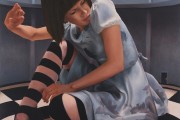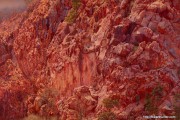Johnny Darko is a unique individual with a distinctive working style. He produces large canvas works created with Gold, silver and copper leaf that have been etched by acid to create an intricate, fantastic surface texture that captivates the eye. I was able to view his work at Greenhill Gallery and they are a must see either there or in his studio in Glenelg (by appointment). The only downside to this wonderful work is that photography simply does not do it justice. Each of the large canvas forms have been coated with a sealing resin that is glossy and reflective. Upon the resin and sometimes under a few layers, fine speckles of material, such as gold dust can be seen. This dimension to the work makes it extremely attractive to the viewer. One must simply examine the work standing in front of it, moving about from side to side to see the full effect of the technique. Darko was originally from the United Kingdom and came out to South Australia and delivered his first exhibition “Tarnished” in 2009. His works are influenced by the worn walls of ancient buildings throughout Europe, archaic churches and worn furnishings. The exhibition is titled “I am king of Salt and Stone:The Alchemical Manuscripts”. This collection draws strongly on early chemical manuscripts as well as religious motifs. He practises a kind of reverse alchemy, instead of turning base metals into precious ones; through his processes he erodes the precious metals transforming them into something altogether new. There is something very ancient inside of daRKo
 “Winter’s Stag” is an ominous work created from gold leaf, acid has decimated the surface, eroded and tarnished the gold. In fact gold is the most nonreactive element, so the reactions and discolouration caused by the acids applied to the surface are caused by the impurities in the gold leaf. This work contains a stark dark “stag” in the centre of the work. It is a smoky faced shape that drifts into the picture from below, whose golden eyes gaze out at the viewer. Its horns are curled appearing more ram like than deer. A tarnished, hazy upper surface balances the form while the intricate textures on the surface interest the eye and envelope the imagination. There is s smoky, burnt appearance upon the surface, yet even this is balanced by the speckled gold dust trapped beneath the layer of resin on the surface. The rectangular shapes of the gold leaf divide the work into sections, a grid pattern that compliments the weathered organic feel. As I look at this work I can see many themes being played out, opposites; the natural world and the constructed, light and dark, good and evil. I feel there is a God like resonance in within the gold leaf of this work, yet the portentous stag seems to bring with it an evil menacing tarnish that might envelop the golden glow. There is within this work a counter play that might describe a cosmic battle that has existed for eons.
“Winter’s Stag” is an ominous work created from gold leaf, acid has decimated the surface, eroded and tarnished the gold. In fact gold is the most nonreactive element, so the reactions and discolouration caused by the acids applied to the surface are caused by the impurities in the gold leaf. This work contains a stark dark “stag” in the centre of the work. It is a smoky faced shape that drifts into the picture from below, whose golden eyes gaze out at the viewer. Its horns are curled appearing more ram like than deer. A tarnished, hazy upper surface balances the form while the intricate textures on the surface interest the eye and envelope the imagination. There is s smoky, burnt appearance upon the surface, yet even this is balanced by the speckled gold dust trapped beneath the layer of resin on the surface. The rectangular shapes of the gold leaf divide the work into sections, a grid pattern that compliments the weathered organic feel. As I look at this work I can see many themes being played out, opposites; the natural world and the constructed, light and dark, good and evil. I feel there is a God like resonance in within the gold leaf of this work, yet the portentous stag seems to bring with it an evil menacing tarnish that might envelop the golden glow. There is within this work a counter play that might describe a cosmic battle that has existed for eons.
 The “Skeptical Chemist” is a work composed of gold, silver and copper leaf etched with acid. The words are from Robert Boyle’s book, the first edition of which was published in 1661. Here Darko has displayed the cover text of the book which reads – “The Sceptical Chymist: or Chymo-Physical Doubts and Paradoxes, Touching the Experiments whereby Vulgar Spagirists are Wont to Endeavour to Evince their Salt, Sulphur and Mercury, to be the True Principles of Things…”
The “Skeptical Chemist” is a work composed of gold, silver and copper leaf etched with acid. The words are from Robert Boyle’s book, the first edition of which was published in 1661. Here Darko has displayed the cover text of the book which reads – “The Sceptical Chymist: or Chymo-Physical Doubts and Paradoxes, Touching the Experiments whereby Vulgar Spagirists are Wont to Endeavour to Evince their Salt, Sulphur and Mercury, to be the True Principles of Things…”
Boyle is known as the father of modern chemistry, and for his roots in alchemy; the book is one of the first to refute the popular notion that the elements composing all things were Earth, Air Fire and Water or Salt, Sulphur and Mercury.
I can see why this interesting historical text was chosen to be featured by Darko. The reference to alchemy and the dawn of new understanding are evident within these words. Each word has been created through masking; the acid etching upon the exposed surface. The letter forms can not exactly be called shiny, they glow! As the viewer looks upon the surface it takes on a vibrancy that is difficult to alliterate. Each square links together as distinct parts of a whole to form the entire work. The single sheets are harmonious with each other. The interesting patterns and textures add a rustic demeanour to the surface, contracting heavily with the words. Generally I tend to see the use of written language on an artwork to be rather loud. However in this case the letter forms are muted by the overall sheen of the surface. It is this key aspect of the application of resin that seems to make it work. Johnny Darko’s unique work is still on display until June 12th at Greenhill Gallery, North Adelaide. If you miss out there is always his studio in Glenelg, details on his website.


